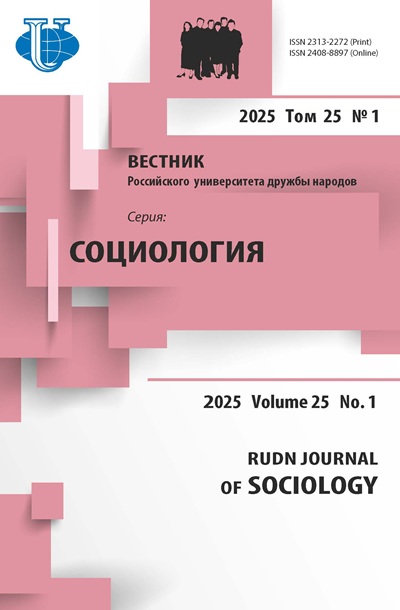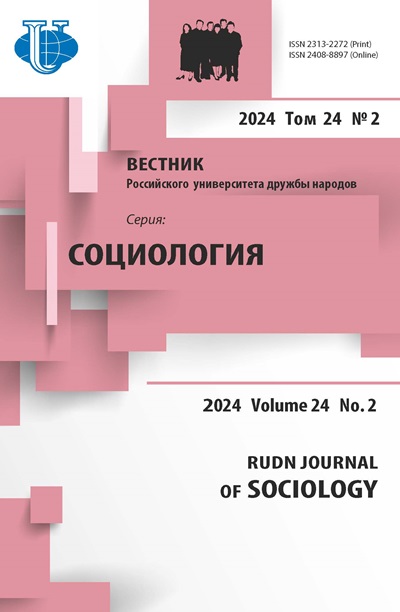Vertical differentiation of the early non-Western societies: A factor of resource availability
- Authors: Davydov S.A.1
-
Affiliations:
- Saint Petersburg state University of Economics
- Issue: Vol 24, No 2 (2024)
- Pages: 277-292
- Section: Theory, Methodology and History of Sociological Research
- URL: https://journals.rudn.ru/sociology/article/view/39926
- DOI: https://doi.org/10.22363/2313-2272-2024-24-2-277-292
- EDN: https://elibrary.ru/NQWWVN
Cite item
Full Text
Abstract
The article aims at explaining the influence of the resource factor on differentiation in the early non-Western societies. The author uses extensive historical and anthropological data and analytical tools of classical and contemporary sociological theories to prove that scientific works consider the sufficiency of life support resources as a significant factor in sociogenesis. However, the direction and mechanism of this factor are interpreted differently due to the qualitative features of societies under study. An increase in the number of life support resources could play a stimulating role in the complication of those social structures that had relatively developed production technologies, which allowed to institutionalize private ownership of the means of production, i.e., the growth of wealth led to an increased exchange and, accordingly, to social inequality and, ultimately, to the state. Social differentiation developed differently in societies that were forced to significantly increase their economic efficiency but did not have developed production technologies or could not borrow them from their neighbors, i.e., the population growth, not supported by an increase in labor productivity, led to a shortage of life support resources. Thus, people were forced to look for more effective forms of labor organization, such as the involvement of large masses of community members in solving general economic problems, which was best ensured by a hierarchical socialeconomic system with elements of coercion and planning. In some areas, population mastered irrigation farming technologies which further accelerated social differentiation. Within this new social structure, clan relations were preserved for some time but only as a means of legitimizing the new order. As vertically integrated relations strengthened, they ceased to need justification due to achieving legitimation and dominance.
About the authors
S. A. Davydov
Saint Petersburg state University of Economics
Author for correspondence.
Email: licurg@inbox.ru
Sadovaya St., 21, Saint Petersburg, 191023, Russia
References
- Bott E. Power and rank in the Kingdom of Tonga. Journal of the Polynesian Society; 1981 (90).
- Burrowa E.G., Spiro M.E. An Atoll Culture: Ethnography of Ifaluk in the Central Carolines. New Haven; 1953.
- Carneiro R.L. Cross-current in the theory of state formation. American Ethnologist. 1987; 14.
- Claessen H.J.M. The early state in Thaiti. Claessen H.J.M., Skalnik P. (Eds.). The Early State. Hague; 1978.
- Cordy R.H. Complex rank cultural systems in Hawaiian Islands: Suggested explanations for their origin. Archeology and Physical Anthropology in Oceania. 1974; IX (2).
- Cordy R.H. A Study of Prehistoric Social Change: The Development of Complex Societies in the Hawaiian Islands. New York; 1981.
- Davies M. Wittfogel’s dilemma: Heterarchy and ethnographic approaches to irrigation management in Eastern Africa and Mesopotamia. World Archaeology. 2009; 41 (1).
- Earle T. How Chiefs Come to Power: The Political Economy in Prehistory. Stanford; 1997.
- Ekholm K. External exchange and transformation of Central African social systems. Friedman J., Rowlands M. (Eds.). The Evolution of Social Systems. London; 1977.
- Emerson R.W. History. Essays by Ralph Waldo Emerson. New York; 1978.
- Firth R. We, the Tikopia. Boston; 1963.
- Force R., Force M. Just One House. A Description and Analysis of Kingship in the Palau Islands. Honolulu; 1972.
- Godelier M. La notion de “production asiatique” et les schémas Marxistes d’évolution des societеs. Garaudy R. (Ed.). Sur le Mode de Production Asiatique. Paris; 1969.
- Hassan F.A., Holmes D.L. The Archaeology of the Umm el-Dabadid Area, Kharga Oasis, Egypt. Cairo; 1985.
- Johnson A.W., Earle T.K. The Evolution of Human Society: From Foraging Group to Agrarian State. Stanford; 1987.
- Kang B.W. Large-scale reservoir construction and political centralization: A case study from ancient Korea. Journal of Anthropological Research. 2006; 62 (2).
- Korn S.R. Hunting the Ramage: Kinship and the organization of political authority in aboriginal Tonga. Journal of Pacific History. 1978; 13.
- Kottak C.Ph. Ecological variables in the origin and evolution of African states. Comparative Studies in Society and History. 1972; 14.
- Labby D. The Demystification of Yap. Chicago; 1976.
- Lees S.H. Irrigation and society. Journal of Archaeological Research. 1994; 2 (4).
- Muller J.-C. Political systems as transformations. Claessen H.J.M., van de Velde P., Smith M.E. (Eds.). Development and Decline: The Evolution of Sociopolitical Organization. South Hadley; 1985.
- Nason J.-C. Political change: Another island perspective. Highes D.T., Lingenfelter S.G. (Eds.). Political Development in Micronesia. Columbus; 1974.
- Price B. Shifts in production and organization: A cluster-interaction model. Current Anthropology. 1977; 18.
- Price D.H. The Evolution of Irrigation in Egypt’s Fayoum Oasis: State, Village and Conveyance Loss. University of Florida; 1993.
- Rizkana I., Seeher J. Maadi II: The Lithic Industries of the Predynastic Settlement. Mainz am Rhein; 1988.
- Sahlins M.D. Poor man, rich man, big man, chief. Political types in Melanesia and Polynesia. Comparative Studies in Society and History. 1963; 5.
- Sahlins M.D. Differentiation by adaptation in Polynesian societies. Journal of the Polynesian Society. 1957; 66 (3).
- Sayer D. Medieval waterways and hydraulic economics: Monasteries, towns and the East Anglian fen. World Archaeology. 2009; 41 (1).
- Service E.R. Origins of the State and Civilization. New York; 1975.
- Service E.R. Primitive Social Organization: An Evolutionary Perspective. New York; 1971.
- Spencer H. Social Statics. New York; 1851.
- Spencer H. The Principles of Sociology. Vol. 2. New York; 1890.
- Stanley D.J., Warne A.G. Nile delta: Recent geological evolution and human impact. Science. 1993.
- Steward J.H. Cultural causality and law. A trial formulation of the development of early civilizations. American Anthropologist. 1949; 51.
- Stride S., Rondelli B., Mantellini S. Canals versus horses: Political power in the oasis of Samarkand. World Archaeology. 2009; 41 (1).
- Webb M. The flag follows trade: An essay on the necessary interaction of military and commercial factors in state formation. Lamberg-Karlovski C., Sabloff J. (Eds.). Ancient Civilization and Trade. Albuquerque; 1975.
- Wendorf F.A., Schild R., Haas H. A new radiocarbon chronology for prehistoric sites in Nubia. Journal of Field Archaeology. 1979; 6.
- Wendorf F.A. The Prehistory of Nubia. Vol. 2. Dallas; 2001.
- Wilkinson R. Poverty and Progress. An Ecological Perspective on Economic Development. New York; 1974.
- Williams M.A.J. Age of alluvial clays in the Western Gezira, Republic of the Sudan. Nature; 1966 (211).
- Wittfogel K.A. Oriental Despotism: A Comparative Study of Total Power. New Haven- London; 1957.
- Grinin L.E. Filosofiya, sotsiologiya i teoriya istorii (Opyt filosofsko-sotsiologicheskogo analiza nekotoryh obshchestvennyh zakonov i postroeniya teorii vsemirno-istoricheskogo protsessa) [Philosophy, Sociology and Theory of History (A Philosophical-Sociological Analysis of Some Social Laws and a Theory of the World-Historical Process)]. Volgograd; 2003. (In Russ.).
- Gumilev L.N. Drevnie tyurki [Ancient Turks]. Moscow; 2008. (In Russ.).
- Konovalov P.B. Tsentralnoaziatsky ochag skifosibirskogo kulturno-istoricheskogo edinstva [Central Asian center of the Scythian-Siberian cultural-historical unity]. Istorikokulturnye svyazi narodov Tsentralnoj Azii. Ulan-Ude; 1983. (In Russ.).
- Korotaev A.V. Stanovlenie i razvitie gosudarstvennyh struktur v Evrazii i Severnoj Afrike (VI-I tys. do n.e.): mir-sistemny kontekst [Formation and development of state structures in Eurasia and North Africa (VI-I millennium BC): A worldsystem context]. Rannee gosudarstvo, ego alternativy i analogi. Volgograd; 2006. (In Russ.).
- Malthus T. Opyt o zakone narodonaseleniya [An Essay on the Principle of Population]. Vol. 4. Petrozavodsk; 1993. (In Russ.).
- Malyavkin A.G. Materialy po istorii ujgurov v IX-XII vv. [Materials on the History of the Uighurs in the 9th - 12th Centuries]. Novosibirsk; 1974. (In Russ.).
- Marx K. Vvedenie (Iz ekonomicheskih rukopisej 1857-1858 godov) [Introduction (From Economic Manuscripts of 1857-1858)]. Marx K., Engels F. Sochineniya. Vol. 12. Moscow; 1959. (In Russ.).
- Marx K. Pismo V.P. Annenkovu, 28 dekabrya 1846 goda [Letter to V.P. Annenkov dated December 28, 1846]. Marx K., Engels F. Sochineniya. Vol. 27. Moscow; 1959. (In Russ.).
- Marx K., Engels F. K kritike politicheskoj ekonomii [Critique of political economy]. Marx K., Engels F. Sochineniya. Vol. 13. Moscow; 1959. (In Russ.).
- Parsons T. Sistema sovremennyh obshchestv [The System of Modern Societies]. Moscow; 1997. (In Russ.).
- Prusakov D.B. O prichine “pozdnego” perekhoda k neolitu [On the reason for the “late” transition to the Neolithic]. Istoriya i Sovremennost. 2005; 2. (In Russ.).
- Sahlins M. Ekonomika kamennogo veka [Stone Age Economics]. Moscow; 1999. (In Russ.).
- Scott J. Protiv zerna: glubinnaya istoriya drevnejshih gosudarstv [Against the Grain: A Deep History of the Earliest States]. Moscow; 2022. (In Russ.).
- Starova O.V. Kultura khudozhestvennoj obrabotki metalla v epokhu plemennyh soyuzov i rannih gosudarstv Zabajkaliya [The culture of the artistic metal processing in the era of tribal unions and early states of Transbaikalia]. Vestnik Buryatskogo Gosudarstvennogo Universiteta. 2010; 14. (In Russ.).
- Tishkov V.A. Rekviem po etnosu: Issledovaniya po sotsialno-kulturnoj antropologii [Requiem for Ethnicity: Studies in Social-Cultural Anthropology]. Moscow; 2003. (In Russ.).
- Tumarkin D.D. Gavajsky narod i amerikanskie kolonizatory [Hawaiian People and American Colonialists]. Moscow; 1971. (In Russ.).
- Khrestomatiya po istorii drevnego mira [Reader on the History of the Ancient World]. Pod red. V.V. Struve. Vol. 1. Drevny vostok. Vvedenie. Moscow; 1950. (In Russ.).
- Tsultem N.-O. Iskusstvo Mongolii s drevnejshih vremen do nachala XX veka [Mongolian Art from Ancient Times to the Early 20th Century]. Moscow; 1982. (In Russ.).
- Shnirelman V.A. Vozniknovenie proizvodyashchego khozyajstva: problema pervichnyh i vtorichnyh ochagov [Origins of the Productive Economy: Primary and Secondary Centers]. Moscow; 1989. (In Russ.).
- Engels F. Manifest kommunisticheskoj partii [Manifesto of the Communist Party]. Marx K., Engels F. Sochineniya. Vol. 21. Moscow; 1959. (In Russ.).
- Engels F. Proiskhozhdenie semiy, chastnoj sobstvennosti i gosudarstva [The origin of the family, private property and the state]. Marx K., Engels F. Sochineniya. Vol. 21. Moscow; 1959. (In Russ.).














